Remove the radiator cap, wet its seal with engine coolant, and install it to a pressure tester.

Never remove the radiator cap when the engine is hot. Serious scalding could be caused by hot fluid under high pressure escaping from the radiator.
When pouring engine coolant, be sure to shut the relay box lid and not to let coolant spill on the electrical parts or the paint. If any coolant spills, rinse it off immediately.
Make sure the engine and radiator are cool to the touch.
Open the radiator cap.
Loosen the drain plug, and drain the coolant.
Tighten the radiator drain plug securely.
Remove, drain and clean the reservoir tank.
Fill water slowly through the radiator cap. Push the upper/lower hoses of the radiator so as to bleed air easily.
Warm the engine until the cooling fan operates 2~3 times.
Accelerate the engine 2~3 times without load.
Wait until the engine is cold.
Repeat the steps 1~8 until the water drained is clean.
Fill fluid mixture with coolant and water(4 : 6) slowly through the radiator cap. Push the upper/lower hoses of the radiator so as to bleed air easily.
Start the engine and run so coolant circulates.
When the cooling fan operates and coolant circulates, refill coolant through the radiator cap.
Repeat 11 until the cooling fan cycles 3 ~ 5 times and bleed air sufficiently out of the cooling system.
Install the radiator cap and fill the reservoir tank to the "MAX"(or "F") line with coolant.
Run the vehicle under idle until the cooling fan operates 2 ~ 3 times.
Stop the engine and wait until coolant gets cool.
Repeat 10 to 15 until the coolant level doesn't fall any more, bleeding air out of the cooling system.
Check the coolant level again in the reservoir tank for 2 ~ 3 days after replacing coolant.
Remove the radiator cap, wet its seal with engine coolant, and install it to a pressure tester.

Apply a pressure of 93 ~ 123kPa (0.95 ~ 1.25kgf/cm², 14 ~ 19psi).
Check for a drop in pressure.
If the pressure drops, replace the cap.
Drain the engine coolant.
System is under high pressure when the engine is hot. To avoid danger of releasing scalding engine coolant, remove the cap only when the engine is cool.
Remove drive belt(A).
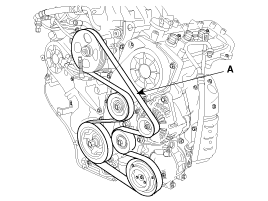
Remove the timing belt.
Remove the water pump(A) and gasket(B).

Drain the engine coolant.
Remove the air cleaner assembly.
Disconnect the radiator upper and lower hose(A, B).

Disconnect the ECT(Engine Coolant Temperature) sensor connector.
Remove the coolant hose related to the heater hoses and the ECT(Engine Coolant Temperature) system.
Remove wiring protector.
Remove water temperature control assembly(A) and the gaskets(B).
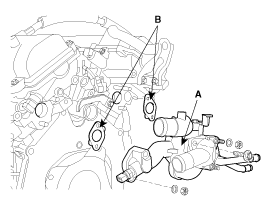
Remove the water pipe(A).
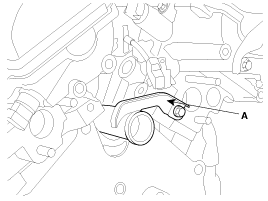
Removal of the thermostat would have an adverse effect, causing a lowering of cooling efficiency. Do not remove the thermostat, even if the engine tends to overheat.
Drain engine coolant so its level is below thermostat.
Remove the coolant inlet pitting(A) and the thermostat(B).
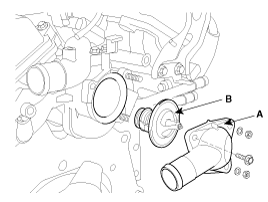
Drain the engine coolant. Remove the radiator cap to speed coolant draining.
Remove the air duct.
Remove the upper radiator hose(A) and lower radiator hose.
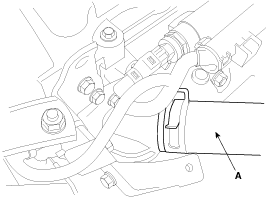
Disconnect the radiator fan connector.(A, B)
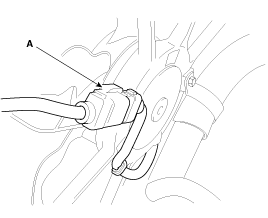

Remove the radiator grill upper cover.(A)

Remove the head lamp washer nozzle cover and front bumper.(Refer to BD group)
Remove the radiator cap hose.(A)
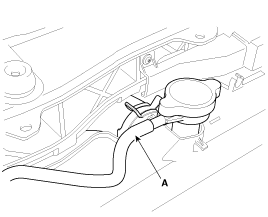
First, remove the cooling fan.(First, separate LH side)
Remove the bracket bolt of radiator lower hose.
Remove the radiator bracket bolt of the radiator upper side(A).
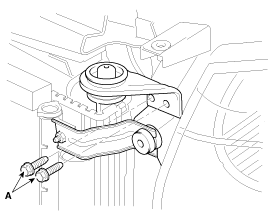
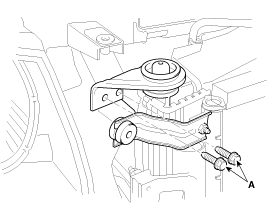
Remove the radiator assembly from the engine.
Install the water pump(A) and a new gasket(B) with the bolts.
Tightening torque
14.7 ~ 21.6Nm (1.5 ~ 2.2kgf.m, 10.8 ~ 15.9lb-ft)

Clean the contacting face before assembling.
Install the timing belt.
Install drive belt(A).

Fill with engine coolant.
Start engine and check for leaks.
Recheck engine coolant level.
Install the water pipe(A).
Tightening torque
16.7 ~ 19.6Nm (1.7 ~ 2.0kgf.m, 12.3 ~ 14.5lb-ft)

Install the water temperature control assembly(A) with a new gasket(B).
Tightening torque
29.4 ~ 41.2Nm(3.0 ~ 4.2kgf.m, 21.7 ~ 30.4lb-ft

Use new O-rings and wet them with water or coolant when reassembling.
Install the wiring protector.
Connect the heater hose and ECT hose.
Connect the ECT sensor connector.
Connect the radiator upper and the lower hose(A).

Install the air cleaner assembly.
Fill with engine coolant.
Start engine and check for leaks.
Recheck engine coolant level.
Place thermostat(B) in coolant inlet pitting(A).
Install the thermostat with the jiggle valve upward.

Install the coolant inlet pitting(A).
Tightening torque
16.66 ~ 19.60Nm (1.7 ~ 2.0kgf.m, 12.30 ~ 14.47lb-ft)
Fill with engine coolant.
Start engine and check for leaks.
Install the engine from radiator assembly.
Install the radiator bracket bolt.(A)


Install the cooling fan.
Install the radiator cap hose.(A)

Install the front bumper and head lamp washer nozzle cover.(Refer to BD group)
Install the radiator grill upper cover.(A)

Connect the radiator fan connector.(A, B)


Install the upper radiator hose.(A)

Install the air duct.
Refill with engine coolant.
Check each part for cracks, damage or wear, and replace the coolant pump assembly if necessary.
Check the bearing for damage, abnormal noise and sluggish rotation, and replace the coolant pump assembly if necessary.
Check for coolant leakage. If coolant leaks from hole, the seal is defective. Replace the coolant pump assembly.
A small amount of "weeping" from the bleed hole is normal.
Immerse the thermostat in water and gradually heat water.
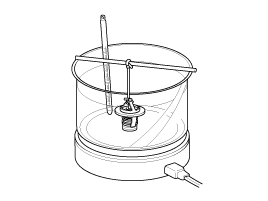
Check the valve opening temperature.
Valve opening temperature : 82°C (177°F)
Full opening temperature : 95°C (205°F)
If the valve opening temperature is not as specified, replace the thermostat.
Check the valve lift.
Valve lift : Min. 10mm (0.4in.) at 95°C (205°F)
If the valve lift is not as specified, replace the thermostat.